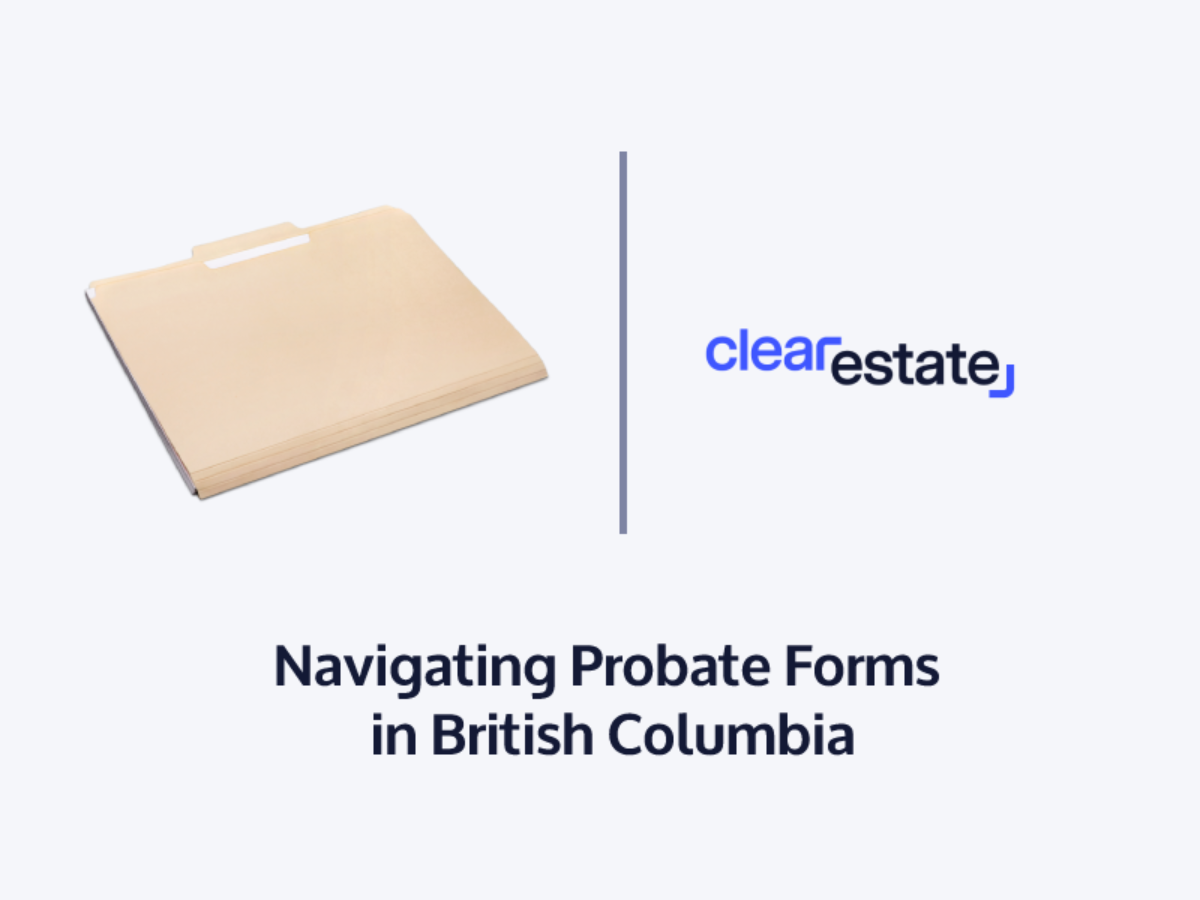Estate Settlement
Dec 04, 2024
How Do Executors Mail Inheritance Checks?
Find out how inheritance checks are mailed, including security measures and what to do if there are delays in receiving them.
Your go-to guide for understanding and filling out Probate Forms in BC. Simplify estate administration today.


Probate is a legal process that confirms the validity of a deceased person's Will and gives the executor—the person named in the Will—the authority to administer the estate. In British Columbia, this process is overseen by the Supreme Court.
When a person dies with a valid Will, the executor applies for a "grant of probate." This grant gives them the legal right to distribute the deceased's assets according to the Will's instructions.
However, when a person dies without a Will—a situation known as "intestate"—the process is slightly different. In such cases, a close relative or other interested party applies for a "grant of administration." This grant gives them the authority to distribute the deceased's assets according to BC's laws of intestacy.
Key terms to understand in this process include:
Understanding probate is crucial for anyone dealing with a deceased person's estate, as it ensures the lawful and orderly distribution of assets.
P1 – Notice of Proposed Application in Relation to Estate: This form is used to notify all beneficiaries and potential interested parties of the applicant's intent to apply for a grant. It should be mailed along with a copy of the Will to all interested parties. This form should be sent at least 21 days before submitting the application for a grant of probate or grant of administration in court.
Insight: It's crucial to send this form to all interested parties, including those who might not be immediate family members. If you're unsure, it's better to err on the side of caution and notify them to avoid potential legal challenges later.
Original Will of the deceased person: The original Will should be filed in court when applying for a grant.
Form P2 – Submission for Estate Grant: This form provides details about the grant application. It should be filed in court after the 21-day waiting period following the mailing of the P1 form.
Form P3 or Form P4 – Affidavit of Applicant: The form to use depends on whether Rule 25-3 of the Supreme Court Rules applies or not. This form should be filed in court along with the P2 form. For applications that are simple, it is recommended to use form P3. The use of a P4 form is recommended for applications with more complex issues.
Form P9 – Affidavit of Delivery: This document attests to the fact that the P1 Preliminary Notice and a copy of the will were delivered to all necessary parties. This form should be filed in court along with the P2 form.
Insight: Keep track of all the parties you've sent the P1 form to. This will make filling out the P9 form easier and more accurate.
Form P10 – Affidavit of Assets and Liabilities: This form sets out all the deceased’s assets and liabilities. It should be filed in court along with the P2 form.
Certificate from the Chief Executive Officer under the Vital Statistics Act: This certificate indicates the results of a search for a wills notice filed by or on behalf of the deceased. It should be filed in court along with the P2 form. This certificate is important to confirm that there are no other Wills that supersede the one you have.
Form P17 – Notice of Renunciation (if applicable): This form is required if one or more of the executors has renounced executorship. It should be filed in court along with the P2 form. ** If an executor chooses not to act, this form is necessary to officially document their renunciation.
Form P34 – Affidavit of Deemed Renunciation (if applicable): This form is required if the executor is deemed under Rule 25-11 of the Supreme Court Rules to have renounced executorship. It should be filed in court along with the P2 form. ** This form is used when an executor doesn't formally renounce but is deemed to have done so, such as when they fail to respond to a citation.
The forms and their timelines are similar to the process with a Will, but there are some differences:
P1 – Notice of Proposed Application in Relation to Estate: This form is used to notify all potential interested parties of the applicant's intent to apply for a grant. It should be mailed to all interested parties at least 21 days before submitting the application for a grant of administration in court.
Form P2 – Submission for Estate Grant: This form provides details about the grant application. It should be filed in court after the 21-day waiting period following the mailing of the P1 form.
Form P5 – Affidavit of the Applicant for Grant of Administration without Will Annexed: This form identifies the applicant and their relationship to the deceased. It should be filed in court along with the P2 form. This form is crucial in cases where there's no Will, as it helps the court understand the applicant's relationship to the deceased and their standing to administer the estate.
Form P9 – Affidavit of Delivery: This document attests that the P1 Preliminary Notice was delivered to all required parties. This form should be filed in court along with the P2 form.
Form P10 – Affidavit of Assets and Liabilities for Domiciled Estate Grant: This form sets out all the deceased’s assets and liabilities. It should be filed in court along with the P2 form.
Insight: In the absence of a Will, accurately identifying and valuing the deceased's assets and liabilities is crucial for fair distribution among heirs.
Certificate of Wills Notice Search: This is obtained by doing a search of the wills registry maintained by the provincial government’s Vital Statistics Agency. It should be filed in court along with the P2 form. Even when there's no known Will, it's important to conduct this search to ensure that there isn't a Will filed with the Vital Statistics Agency.
Remember, these forms and processes can be complex and time-consuming. It's often beneficial to seek professional guidance when dealing with probate matters, especially when dealing with large or complex estates.
We understand that navigating the intricacies of estate administration can feel daunting - as you've seen, whether there is a will or not, the process requires accuracy, thoroughness, and meticulous attention to detail. Missteps can cause delays or lead to disputes that could have been avoided.
Instead of shouldering this burden alone, imagine having a guide to provide insight, streamline the process, and allow you peace of mind. This is where ClearEstate's expertise comes into play. We're offering you the chance to kickstart your journey toward a seamless estate administration process.
Don't just "book a free consultation." Rather, "Embark on your path to hassle-free estate resolution today." There's no credit card required, no obligation, and most importantly, no reason to wait. Start taking the proactive steps toward a simplified estate administration process now, and let us shoulder the complexity for you.
Take that first step today. Secure your free consultation now and move towards an easier estate administration process. We're here to help.
 Simplify Probate Today
Simplify Probate Today
Get expert guidance from our probate specialists who've helped 10,000+ families.
Book a free consultation today